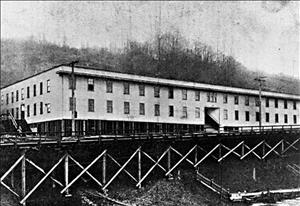On August 13, 1951, a B-50 Superfortress bomber develops engine trouble immediately after taking off from Boeing Field. The plane glances off the Sicks' Seattle Brewing and Malting Company and slams into nearby Lester Apartments on Beacon Hill, killing 11 people and injuring 11 others. The tragic accident also claims a piece of Seattle's infamous past.
A Problem After Takeoff
The B-50 bomber was one of many undergoing modification by Boeing. The 164,000-pound aircraft usually carried a crew of 11, but this routine flight to check out military equipment carried only six -- three Air Force men and three Boeing employees. At approximately 2:15 p.m., seconds after takeoff, radio operators at Boeing Field received a distress call from the pilot.
Witnesses looked skyward and saw the plane struggling to gain altitude. The nose was pointing up, but the plane was wobbling and descending. Suddenly, it turned abruptly toward the brewery until the wings were almost vertical. The starboard wing nicked the top of the building, cartwheeling the aircraft into the nearby apartment house. All engines were on, and the plane was loaded with 4,000 gallons of fuel.
It hit with a dull thud and exploded into flames. Thick black smoke poured out of the apartment house. The crew was dead, along with a few of the building residents. The rest scrambled to save their lives.
Rescue on the Ground
Policeman at the Georgetown Precinct Station watched the accident and turned in a fire alarm immediately. Firemen were on the scene within minutes, by which time workers from the brewery were already there breaking windows and doors to get residents to safety. One third of the three-story frame building was demolished, and the rest of the wooden structure was burning fast.
Nineteen-year-old Julia Thomas threw her baby out a second-story window into the arms of her husband John waiting below. Seventy-six-year-old Peter Nelson, his hands and face burnt, searched desperately for his dog Tippy, to no avail. Some residents sat in the parking lot in shock. Others were carried out on stretchers and transported to the hospital.
Fireman fought the flames as best they could, but the heat proved to be too great. The wreckage of the plane was not strewn over the hillside, but lay within the north end of the demolished apartment building, a massive ball of twisted metal. It burned for hours.
Aftermath
The next day, residents returned to search for belongings, with little luck. A man asked fire officials to look for his wedding ring that he had left on a dresser in his room. The ring, dresser, and room were long gone. Peter Nelson, his hands and face bandaged, searched the nearby woods calling out for his beloved Tippy. Nelson came to the sad realization that Tippy must have gotten scared and hid under the bed as the building burned to the ground.
All told, 11 people died in the accident -- the six bomber crewmembers and three men and two women from the apartment house. Eleven people were hospitalized from burns or cuts received while trying to escape. Thankfully, many residents of the 51-unit building were at work, otherwise the death toll would have been much higher.
The widows of the airmen choked back tears as they talked with reporters. Crewman Kenneth Barrick left behind three young daughters. Four-year-old Kristen, sensing that something bad had happened, told her mother, "I wish Daddy had never gone to work." The wife of pilot and World War II veteran Lloyd Vanderwielen noted that her husband had only recently been recalled to active duty at the onset of the Korean War.
Postscript
Unbeknownst to many, the tragic crash also brought an end to a piece of Seattle's more infamous past. The Lester Apartments, for years a home for working-class families and fixed-income residents, had an unseemly history that was rarely discussed by the few who remembered it.
In 1910, Hiram Gill (1866-1919) was elected mayor of Seattle in an administration rife with corruption. Gill's chief of police, Charles Wappenstein, cut a deal with two vice-lords wherein he received $10 a month for each of the approximately 500 prostitutes in Seattle. Business was so good that the men began building a 500-room brothel on the western slope of Beacon Hill to further pad their bank accounts.
A "friendly" City Council cut the builders some slack and gave them a 15-year lease. By the time construction was complete, the local citizenry had had enough of such blatant debauchery at such a high level of office, and a recall petition was circulated against the mayor. Gill was turned out of office -- he was elected again in 1914 after vowing to crack down on vice -- and Wappenstein was sent to the state penitentiary.
What was once proclaimed the largest bordello in the world fell into disuse. Later, the 500 "cribs" were combined into multi-room apartments, and the building's proximity to Boeing Field led many workers to take up residence there, especially during World War II. Few knew of the building's history. At some point, it was renamed the Lester Apartments. They were destroyed in the maelstrom on August 13, 1951.

